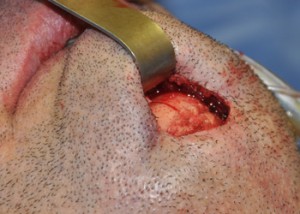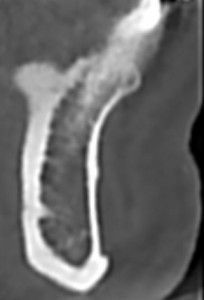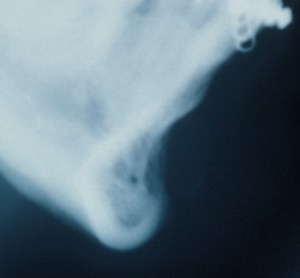One of the most commonly performed facial augmentation procedures is the placement of a chin implant. Whether it is done for significant microgenia (short chin) or as a complement in rhinoplasty and facelifts for less severe chin deficiencies, chin implants represent an historic and usually straightforward aesthetic facial procedure. Chin implants date back as far as the 1950s and were the first type of synthetic implant placed in the face. While other materials had been used both before that and since, the use of silicone is by far what makes up the vast majority of chin implants that have ever been placed.
Chin implants have a history and a much talked about issue of potential ‘erosion’ into the underlying chin (mandibular symphyseal) bone. This issue has raised all sorts of concerns from patients considering chin augmentation, fearing that it is a destructive process that eats the bone and ultimately poses other problems. For some potential patients, this is issue is so dissuasive that they will either not have an implant for their chin augmentation or will choose a sliding genioplasty or another implant material because they feel it is safer.

The biology of any implant that is placed in the body under pressure is that it will cause some surrounding natural tissue absorption. The implant itself is chemically inert so when it pushes on the overlying tissues, as all augmentation implants do, the body adapts to the pressure of the implant by some natural tissue resorption to relieve the pressure or push of the implant. This is well known, for example, in breast augmentation. Over time, the thickness of the breast tissue between the implant and the overlying skin thins due to the pressure of the implant on it. This is why saline breast implants develop more visible rippling over time and women with any type of implant feels that their breasts are a bit smaller. This is a passive tissue remodeling process not an active inflammatory erosive reaction in response to the composition of the material.
Many, but not all, chin implants will develop a minor amount of adaption of the underlying bone which is best called ‘implant settling’. Usually it is not more than a millimeter or two. It is not uncommon to see the the implant sizing number or other markings of the implant on the bone as part of the settling process. When the implant is properly positioned over the thicker bony cortex of the lower chin, this is about the implant settling one will see. In very large chin implants in very short chins, the amount of implant settling may be a few millimeters more.

But the number of true chin problems (tooth root exposure, infection) that have resulted from such radiographically seen cases of implant settling is extremely rare and very few cases have ever been reported in the medical literature. (I actually know of none…but I will assume that there have had to be several in the past fifty years)
In conclusion, the phenomenon of chin implant erosion is a myth. Rather it is the mislabeling of a natural process of tissue adaptation to the presence of an implant. It is neither active, inflammatory or a progressive process. Rather it is a passive tissue remodeling process that is self-limiting and of no aesthetic or biologic concern. It is not exclusive to silicone chin implants and can occur with all chin implant materials. With proper chin implant positioning below the apices of the incisor tooth roots, even this remote possibility of potential impingement is eliminated. Interestingly, such tissue remodeling is not seen on any other facial implantation site other than that of the chin.
Dr. Barry Eppley
Indianapolis, Indiana



